Water Recycling Treatment Process
How Does Water Recycling Work?
The water recycling process utilizes very basic physical, biological and chemical principles to remove contaminants from water. Use of mechanical or physical systems to treat wastewater is generally referred to as primary treatment. Use of biological processes to provide further treatment is referred to as secondary treatment. Additional purification is called tertiary or advanced treatment.
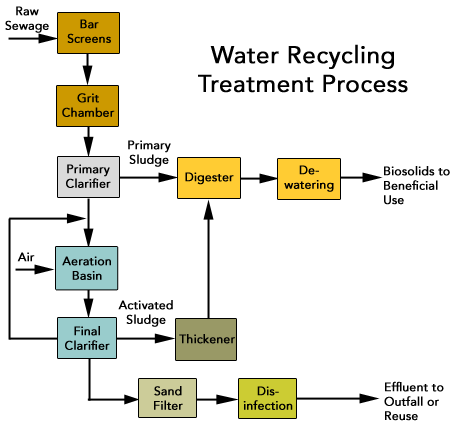
Primary Treatment
Primary treatment uses simple mechanical and physical processes to remove approximately half of the contaminants from wastewater.
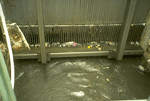 |
Bar screens: To begin the water recycling process, incoming raw sewage is routed through mechanical bar screens, removing large solids such as sticks, rags, and plastic material from the wastewater stream. A horizontal rake on a toothed gear drive rakes the bars and removes the captured material to a conveyor that deposits the material into a dumpster for removal to the sanitary landfill. |
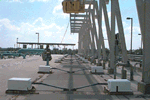 |
Grit chamber: As wastewater flow enters aerated grit chambers, the stream is saturated with fine air bubbles to encourage the settling of fine grit particles. |
 |
Primary clarification: The wastewater continues to primary clarifiers, where the flow velocity is slowed to promote solids settling. Biosolids removed at this point are digested, dewatered, and used for beneficial purposes like conditioning soil or composting. |
Secondary Treatment or “Bug Farming”
Secondary treatment uses biological processes to remove most of the remaining contaminants. Many operators of WRC’s consider themselves “bug farmers” since they are in the business of growing and harvesting a healthy population of microorganisms.
 |
Aeration Basins: Water flows into aeration basins where oxygen is mixed with the water. Bacterial microorganisms consume the organic material as food. They convert non-settleable solids to settleable solids and are later themselves captured in final clarifiers, ending up in wastewater biosolids. |
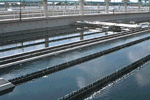 |
Final Clarifiers: Most of the solids that settle out in final clarifiers are thickened and digested, but some are returned to the aeration tank to reseed incoming water with hungry microorganisms. |
Advanced Treatment and Disinfection
After the bugs do their work, water is filtered through sand before undergoing chemical disinfection in chlorine contact chambers, used to kill any remaining microorganisms. It is not desirable to have residual chlorine in the rivers and lakes, so chlorine is then removed using sulfur dioxide. This protects the aquatic life in the receiving stream.
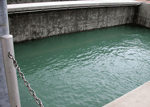 |
Filters: When the flow leaves the final clarifiers it enters into effluent filters, where any remaining particulate matter is filtered out. Filters are generally placed between the final clarifier and disinfection. |
 |
Disinfection and Dechlorination: After 20 minutes of chlorination to ensure the destruction of any pathogenic organisms, it’s then dechlorinated with sulfur dioxide to safeguard the receiving stream. |
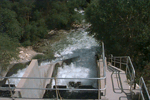 |
Outfall: The water, now fully treated and recycled, is ready for release to the environment. The point where recycled water is discharged to a stream or body of water is called the outfall. |
Solids Processing
The by-product of treated residues generated during the water recycling process are called biosolids. As a natural organic fertilizer and soil conditioner, biosolids provide a full complement of the essential nutrients and micronutrients necessary for healthy plant growth and can be used in agriculture (direct land application) or they can be made into compost for application on lawns, gardens, and trees.
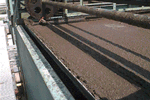 |
Thickener: Air is forced into water in a pressure chamber where the air becomes dissolved in the liquid. The mixture is then released into the sludge where the tiny air bubbles rise and carry the solids with them to the surface. |
 |
Anaerobic Digester: Settled sludge in the primary clarifiers is pumped to anaerobic digesters for stabilization. The tank is usually completely sealed to keep air from getting inside. Anaerobic bacteria thrive in an environment without dissolved oxygen by using the oxygen which is chemically combined with their food supply. |
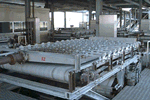 |
De-watering: Digested sludge is de-watered by either squeezing the water out of the sludge using mechanical means like a belt-filter press, or letting mother nature do the job by pouring the sludge onto drying beds. |